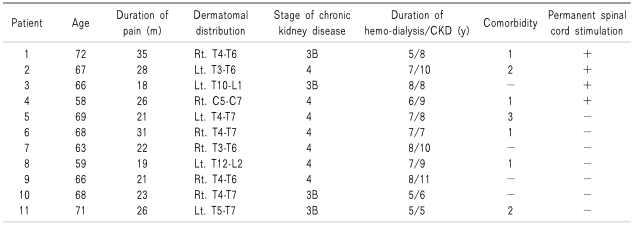1. Sampathkumar P, Drage LA, Martin DP. Herpes zoster (shingles) and postherpetic neuralgia. Mayo Clin Proc. 2009; 84:274–280. PMID:
19252116.

2. Lee JH, Park SK, Lee DI, Jung JK, Lim HK, Cha YD. Assessment of the quality of postherpetic neuralgia related Korean internet sites. Korean J Pain. 2009; 22:141–145.

3. Sim WS, Choi JH, Han KR, Kim YC. Treatment of herpes zoster and postherpetic neuralgia. Korean J Pain. 2008; 21:93–105.

4. Choe H, Han YJ. A clinical study on the treatment of postherpetic neuralgia. J Korean Pain Soc. 1990; 3:131–138.
5. Kim HK, Kim ST, Jung JW, Keoun JY, Kim IS, Chung KS. Lower level laser therapy on postherpetic neuralgia. J Korean Pain Soc. 1992; 5:258–262.
6. Lee DI, Kim DO, Kim KS, Kwon MI, Shin KI, Kang WJ. Gabapentin for the treatment of postherpetic neuralgia. J Korean Pain Soc. 1999; 12:188–190.
7. Lee JH, Kim TY, Ha SH, Kwon YE, Yoon CS. Pulsed radiofrequency lesioning of supraorbital and supratrochlear nerve in postherpetic neuralgia: a report of 2 cases. J Korean Pain Soc. 2004; 17:239–242.

8. Kim WY, Moon DE, Choi JH, Park CM, Han SM, Kim SH. The effect of spinal cord stimulation in patients with complex regional pain syndrome. Korean J Pain. 2006; 19:152–158.

9. Kim YJ, Kim MH, Lim SH, Lee JH, Lee KM, Cheong SH, et al. Treatment of tremor and spasticity in failed back surgery syndrome with spinal cord stimulation: a case report. Korean J Pain. 2006; 19:107–110.

10. Costantini A. Spinal cord stimulation. Minerva Anestesiol. 2005; 71:471–474. PMID:
16012421.
11. Kim YC, Kim SH, Cho JY, Hong JH. Cervical spinal cord stimulation using an 8 electrode lead in a patient with complex regional pain syndrome type I: a case report. Korean J Pain. 2007; 20:186–189.

12. Benzon HT, Chekka K, Darnule A, Chung B, Wille O, Malik K. Evidence-based case report: the prevention and management of postherpetic neuralgia with emphasis on interventional procedures. Reg Anesth Pain Med. 2009; 34:514–521. PMID:
19920429.
13. Kumar K, Toth C, Nath RK. Spinal cord stimulation for chronic pain in peripheral neuropathy. Surg Neurol. 1996; 46:363–369. PMID:
8876718.

14. Harke H, Gretenkort P, Ladleif HU, Koester P, Rahman S. Spinal cord stimulation in postherpetic neuralgia and in acute herpes zoster pain. Anesth Analg. 2002; 94:694–700. PMID:
11867400.

15. Iseki M, Morita Y, Nakamura Y, Ifuku M, Komatsu S. Efficacy of limited-duration spinal cord stimulation for subacute postherpetic neuralgia. Ann Acad Med Singapore. 2009; 38:1004–1006. PMID:
19956824.
16. Meglio M, Cioni B, Prezioso A, Talamonti G. Spinal cord stimulation (SCS) in the treatment of postherpetic pain. Acta Neurochir Suppl (Wien). 1989; 46:65–66. PMID:
2788976.

17. Kouroukli I, Neofytos D, Panaretou V, Zompolas V, Papastergiou D, Sanidas G, et al. Peripheral subcutaneous stimulation for the treatment of intractable postherpetic neuralgia: two case reports and literature review. Pain Pract. 2009; 9:225–229. PMID:
19226314.

18. Upadhyay SP, Rana SP, Mishra S, Bhatnagar S. Successful treatment of an intractable postherpetic neuralgia (PHN) using peripheral nerve field stimulation (PNFS). Am J Hosp Palliat Care. 2010; 27:59–62. PMID:
19700650.

19. Kim C. Pathophysiology of postherpetic neuralgia. J Korean Pain Soc. 2004; 17(Suppl):13–16.






 PDF
PDF Citation
Citation Print
Print



 XML Download
XML Download